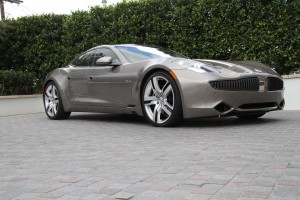The National Highway Traffic Safety Administration is the latest to wade into the debris trying to figure out the cause of a fire in a Texas garage, earlier this month, that consumed a Fisker Karma and several other luxury vehicles.
The conflagration was originally blamed by local authorities on the Fisker plug-in sports car but that initial explanation is being challenged by the carmaker – which pointedly revealed that the car’s lithium-ion battery pack was intact after the blaze. For its part, Fisker has suggested there might even be some mischief at work, hinting that the fire might have been purposely set.
For its part, NHTSA is simply describing the investigation as “ongoing,” and declining to join the finger-pointing.
“We are still engaged in that activity, and no determination has been made at this time,” Claude Harris, NHTSA’s director of vehicle compliance, said during an electric vehicle safety forum.
The safety of lithium-ion batteries has come into the spotlight in recent months, and was highlighted by a series of fires involving the Chevrolet Volt following NHTSA crash testing. The agency briefly opened an investigation but later closed the case after it appeared the problem was related to testing procedures that failed to discharge the Volt’s batteries after the crash. GM subsequently agreed to beef up the protection built-into the plug-in hybrid’s battery case.
The fire in Sugar Land, Texas destroyed the $103,000 Fisker but the battery pack was intact, spokesman Roger Ormisher noted in an e-mail to TheDetroitBureau.com.
Some observers have questioned whether the fire could have been caused by overheating in another part of the vehicle and cite the owners claim that he smelled something that appeared to be burning when he parked the vehicle in his garage.
But there have also been questions raised about whether the fire might have been deliberately set, investigators noting, among other things, that a sizable pile of fireworks were stored in the garage.
While Fisker is clearly hoping to have the investigation clear the Karma the question is whether the headlines will have hurt the car’s image. Since its official launch earlier this year, the sleek Karma has received a mix bag of reviews, critics praising its styling but faulting its more than 5,000-pound mass and the consequent impact that has had on performance.
The fire might also complicate Fisker’s efforts to raise private equity to offset the loss of a promised federal loan needed to finish development of its second vehicle, the Atlantic, which made its debut in New York last month. (Click Here for more on the Atlantic preview.)
The California start-up initially received a $528 million Department of Energy loan as part of a program designed to promote the development of clean, high-mileage vehicles. But after admittedly missing key targets, including a delay in the launch of the Karma, the DoE froze the loan. Fisker has been struggling to convince the government to re-activate it but many sources believe that in the current political environment that is unlikely – at least until after the upcoming presidential election.
In the meantime, Fisker claims to have raised several hundred million dollars from investors but still needs perhaps a third of a billion more to bring Atlantic – formerly known by the codename Project Nina – to market.
It will certainly help the company to be cleared in the Texas fire. But NHTSA officials are providing no timetable for completing their own investigation.

